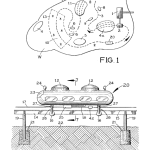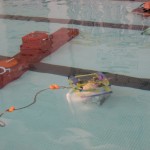![]() Deep Sea News has been following the story of the world’s oldest living animals, the deep-sea Leiopathes black corals and Gerardia gold corals from 300m depth in Hawaii. Both are zoantharian or “zoanthid corals” that excrete a strong proteinaceous axis. The branches of these corals suggest gold coral colonies can be as old 2700 years, and deep black corals can be older than 4000 (Roark et al 2009). The genera are broadly distributed in the Pacific and West Atlantic.
Deep Sea News has been following the story of the world’s oldest living animals, the deep-sea Leiopathes black corals and Gerardia gold corals from 300m depth in Hawaii. Both are zoantharian or “zoanthid corals” that excrete a strong proteinaceous axis. The branches of these corals suggest gold coral colonies can be as old 2700 years, and deep black corals can be older than 4000 (Roark et al 2009). The genera are broadly distributed in the Pacific and West Atlantic.
In the latest developments, WolfpackSteve posted video of the living millennials at 1400 feet depth, presumably in Caribbean waters. This is the first time deep-sea gold coral colonies are shown on YouTube. Shallow colonies have been reported from scuba depths before. The corals were filmed from Karl Stanley’s custom made submarine the Idabel.
The colonies are sessile, that is, non-moving suspension feeders. Sponges are filter feeders, equally boring to watch. If you could zoom in very closely you would notice hundreds of small 4-5 mm polyps joined by small canals in the living tissue. Dozens of brittlestars undulate like worms, crawling around the deep sea fan. Brittlestars are suspension feeding echinoderms often found in close association with deep-sea corals.
This is great imagery of living gold coral habitat. Be sure to watch in “high quality” mode. Turn down your audio first, because the soundtrack kills. Take a tip from Isidella. Wolfpacksteve needs to hook it up with some of that sweet music Karl Stanley plays on his stereo while descending the wall off Roatan, in the Caribbean Honduras.
The corals themselves are colonial organisms closely related to hard and soft zoanthid corals often found in marine aquaria. Judging from the size of this colony, compared to Hawaiian images, this zoantharian coral is ostensibly 2000 years old or more, an order of magnitude older than the next closest long lived marine invertebrate, the quahog.
Citation:
Roark, E., Guilderson, T., Dunbar, R., Fallon, S., & Mucciarone, D. (2009). Extreme longevity in proteinaceous deep-sea corals Proceedings of the National Academy of Sciences, 106 (13), 5204-5208 DOI: 10.1073/pnas.0810875106






These are fascinating. But what is the scale? Is the coral 10 cm high or 1 m? or what?
I suspect that you don’t find them in the shallows because they’ve all been knocked down by trawlers pulling two-ton metal gates across the sea floor at 30 knots.
The gold coral is approximately 1.5-2m across. Each brittle star is about the size of a human hand.
The gold coral is approximately 1.5-2m across ??? So wonderful :)